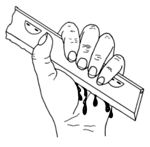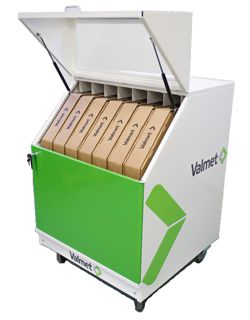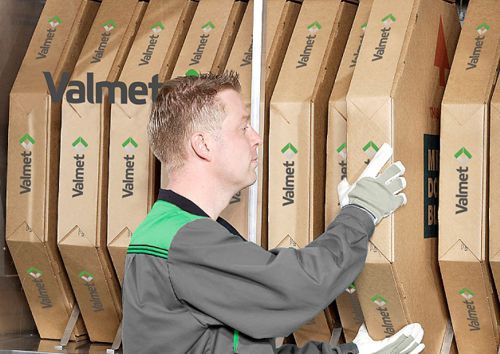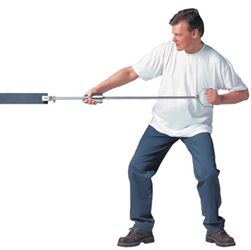Doctoring safety - know the hazards and upgrade safety equipment
Doctors are designed to be safe. Whenever possible, all known risks and hazards are eliminated through design, installation planning and appropriate training. Hazards that cannot be completely removed this way are identified and their impact is eliminated or limited by means of safety devices and instructions.
Guarding
Doctors are not normally equipped with mechanical guards. Different interlocks and alarms are implemented in the control systems of the various machine sections depending on the operation of doctors.
Hazards
Crushing hazard
Doctors do not produce a crushing hazard during machine operation as their operating range is out of human reach. If a person for some reason enters the operating range of a doctor, the clearance between the roll and doctor is so small that no crushing hazard is created. A crushing hazard still exists for the person's fingers.
A crushing hazard is produced by doctor transfers, lifting, and maintenance work when changing doctor components. These include the turning of doctors from transfer position to lifting position, lifting of doctors, as well as various maintenance actions, such as bearing replacements and lifts. Following operating and maintenance instructions and wearing appropriate personal protective gear will reduce the risk of crushing.
Cutting hazard

Entanglement hazard
Doctors do not entail an entanglement hazard as such, as they are out of human reach. Do not attempt to remove any clogs while the machine is in operation. If an attempt is made to remove a clog by hand or using a tool of some sort, the person's hand or tool used can get stuck in the doctor gap and pull the person into the running machine.

 |
NOTE: Only compressed air or cleaning solutions may be used for removing impurities and clogs. Use personal protective gear when cleaning the machine with compressed air or pressurized water. |

High-pressure fluid hazard
A doctor does not produce a high-pressure fluid hazard as such, but if a hose in the doctor's oscillator or hydraulic cylinder hydraulics breaks, this type of a hazard may be created. Since doctors are out of human reach, the risk of direct personal injury is minor.
Slipping, tripping, and falling hazard
Slipping, tripping and falling hazards relate to doctor hose and blade replacements, where situations caused by slipping and resulting falls are always serious.
Hoses and blades can only be changed while the machine is not in operation. Wear a safety harness during work as appropriate. Always remove any oil and other impurities off the floor after completing your work. Do not walk on the doctor or blade holder to avoid falling or damaging the blade holder. Keeping working areas clean and neat helps to improve the safety of
workers.
Hot fluids, surfaces and conditions
Doctors may be steam heated. The temperature of steam is 105-160°C (220-320°F), which makes all doctor surfaces hot. Touching doctor surfaces may cause burns.

 |
WARNING: Do not touch hot surfaces without appropriate protective gear. Warning signs should be posted at these hazardous areas. |


 |
WARNING: Leaks in steam pipes may constitute a serious hazard to anyone in the vicinity of the machine. |

Doctors are out of human reach while the machine is in operation, and there is no immediate danger of injury. Systematic monitoring and repairs will reduce risks related to high-temperature steam.
Equipment for doctor blade storage
Technology is available to accurately, conveniently and safely store doctor blades while making very efficient use of space.
Valmet Doctor Blade Cabinet, the easy way of storing doctor blades
Valmet Doctor Blade Cabinet helps store doctor blades next to the machine without the need for storeroom inventory. The cabinet is a doctor blade storage container capable of holding 10, 15, or 20 doctor blade boxes, depending on the model. Doctor blades are supplied direct to a Valmet Doctor Blade Cabinet located in the machine room. Each blade box is clearly marked indicating the blade position, blade material and blade dimensions, which makes blade changes simpler and safer.
Valmet Doctor Blade Cabinet can be located close to the production line in the machine room, and can also function with consignment inventory. In this case, Valmet Doctor Blade Service assumes responsibility for the supply and storage of all blades.
Valmet Doctor Blade Trolley, for safe and efficient blade handling

The mobile nature of the Valmet Doctor Blade Trolley allows the operator to move blades close to the machine prior to installing the blade. The blade is then pulled out of the box and inserted directly into the blade holder, eliminating installation damage.

Blade box, for blade handling and transportation
A blade box provides easy and safe handling of doctor blades, and is labeled for each position. Each blade box holds up to 10 blades. Blades are pulled from the box like a hose off a reel for easy installation into the holder.
Equipment for doctor blade handling
After safe and efficient storage of doctor blades is achieved, there are multiple options available to facilitate insertion, extraction, reuse and recycling of the blades.
Valmet Doctor Blade Puller firmly grips the surface of a blade

Valmet Blade Cutter shreds used doctor blades
Valmet Blade Cutter is designed to minimize used blade handling. It cuts used doctor blades into 3 inch (90 mm) pieces. Design features include improved safety and reduction of waste bulk.
For more information on improving safety in the doctoring processes, contact your Valmet representative.